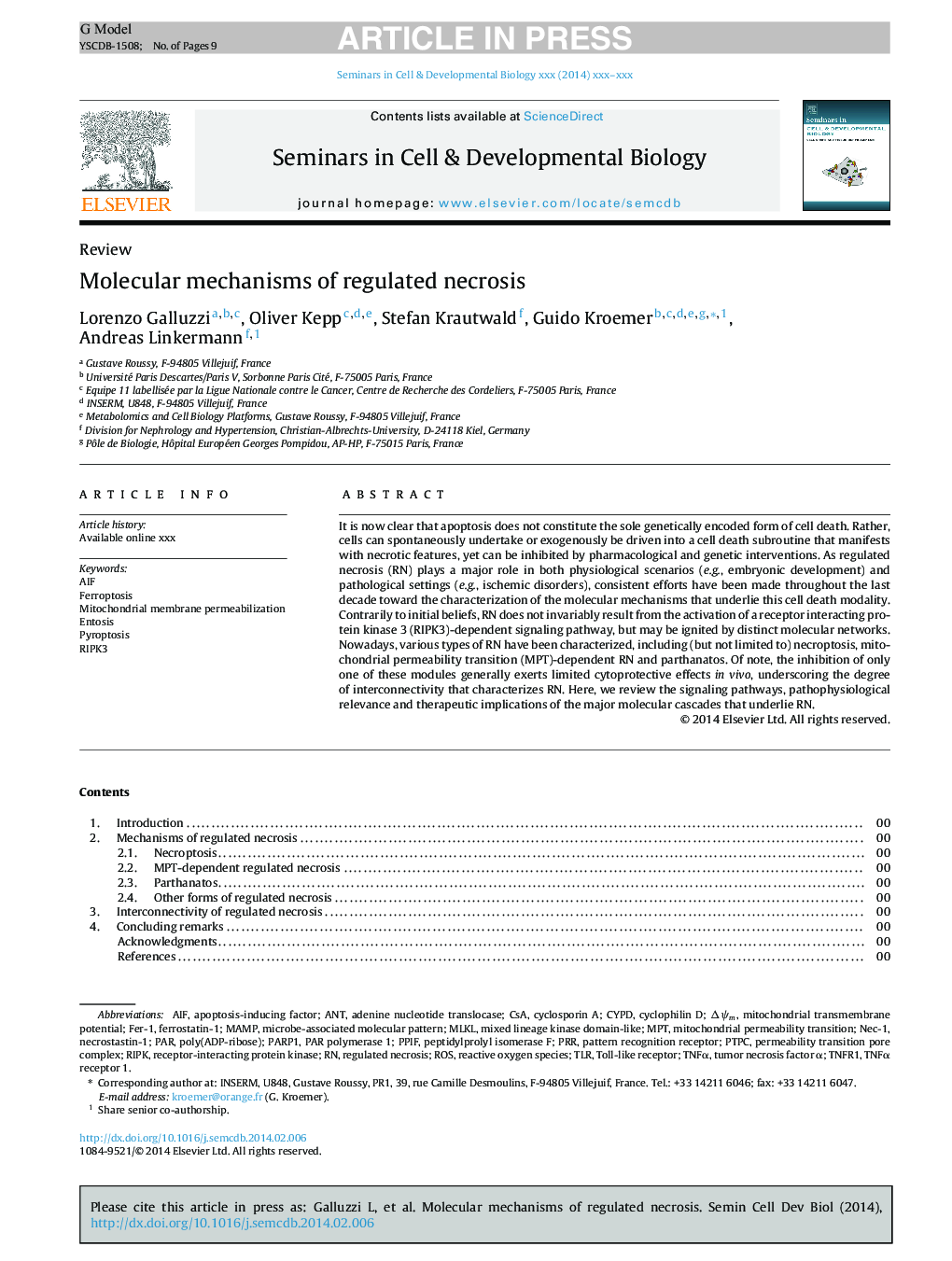| کد مقاله | کد نشریه | سال انتشار | مقاله انگلیسی | نسخه تمام متن |
|---|---|---|---|---|
| 8480545 | 1551387 | 2014 | 9 صفحه PDF | دانلود رایگان |
عنوان انگلیسی مقاله ISI
Molecular mechanisms of regulated necrosis
ترجمه فارسی عنوان
مکانیزم های مولکولی نکروز تنظیم شده
دانلود مقاله + سفارش ترجمه
دانلود مقاله ISI انگلیسی
رایگان برای ایرانیان
کلمات کلیدی
MLKLRipk3Cyclophilin DPARP1PRRCypDTLRΔΨmTNFR1MPTANTferrostatin-1PTPCppifTNFα receptor 1TNFαNec-1 - NEC-1ROS - ROSAIF - آیفونMicrobe-associated molecular pattern - الگوی مولکولی مرتبط با میکروبmitochondrial permeability transition - انتقال نفوذپذیری میتوکندریEntosis - انستیزCSA - ایالات مؤتلفهٔ آمریکاadenine nucleotide translocase - ترانسکوز نوکلئوتید آدنینPar - توسطtumor necrosis factor α - تومور نکروز عامل αToll-like receptor - تیالآرRIPK - ریپکcyclosporin A - سیکلوسپورین Aapoptosis-inducing factor - عامل القاء آپوپتوزFerroptosis - فروتوزیسMAMP - مامانpermeability transition pore complex - مجتمع پراکندگی گذارmixed lineage kinase domain-like - مخلوط رده کیناز مانند دامنهMitochondrial membrane permeabilization - نفوذ پذیری غشای میتوکندریregulated necrosis - نکروز تنظیم شدهMitochondrial transmembrane potential - پتانسیل ترانزیتی میتوکندریreceptor-interacting protein kinase - پروتئین کیناز گیرنده گیرندهpyroptosis - پریپتوزیسPoly(ADP-ribose) - پلی (ADP-ribose)Reactive oxygen species - گونههای فعال اکسیژنpattern recognition receptor - گیرنده شناسایی الگو
موضوعات مرتبط
علوم زیستی و بیوفناوری
بیوشیمی، ژنتیک و زیست شناسی مولکولی
بیولوژی سلول
چکیده انگلیسی
It is now clear that apoptosis does not constitute the sole genetically encoded form of cell death. Rather, cells can spontaneously undertake or exogenously be driven into a cell death subroutine that manifests with necrotic features, yet can be inhibited by pharmacological and genetic interventions. As regulated necrosis (RN) plays a major role in both physiological scenarios (e.g., embryonic development) and pathological settings (e.g., ischemic disorders), consistent efforts have been made throughout the last decade toward the characterization of the molecular mechanisms that underlie this cell death modality. Contrarily to initial beliefs, RN does not invariably result from the activation of a receptor interacting protein kinase 3 (RIPK3)-dependent signaling pathway, but may be ignited by distinct molecular networks. Nowadays, various types of RN have been characterized, including (but not limited to) necroptosis, mitochondrial permeability transition (MPT)-dependent RN and parthanatos. Of note, the inhibition of only one of these modules generally exerts limited cytoprotective effects in vivo, underscoring the degree of interconnectivity that characterizes RN. Here, we review the signaling pathways, pathophysiological relevance and therapeutic implications of the major molecular cascades that underlie RN.
ناشر
Database: Elsevier - ScienceDirect (ساینس دایرکت)
Journal: Seminars in Cell & Developmental Biology - Volume 35, November 2014, Pages 24-32
Journal: Seminars in Cell & Developmental Biology - Volume 35, November 2014, Pages 24-32
نویسندگان
Lorenzo Galluzzi, Oliver Kepp, Stefan Krautwald, Guido Kroemer, Andreas Linkermann,
